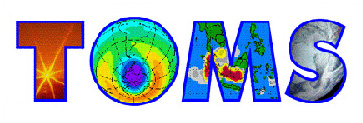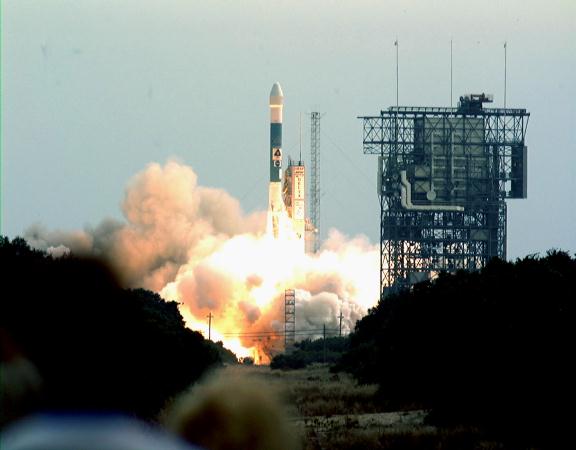
By Ken Schwer
As I stood harnessed in the bucket truck above the Taurus launch vehicle three days before launch, all the difficulties, successes, and memories of this mission came to mind.
I had the privilege of being the project manager on the Quik Total Ozone Mapping Spectrometer (QuikTOMS) Mission. After a lot of hard work and dedication, our team had the mission ready for launch in less than two years. This project was started during the height of NASA’s Faster, Better, Cheaper (FBC) era. Besides the normal difficulties of developing a mission under FBC conditions, we were working under an increasingly risk-averse environment due to recent Mars mission failures. This made things even more stressful than they already can be on an FBC project.
Getting QuikTOMS through its final hurdles was especially difficult. Our most recent troubles involved getting everybody in place for the launch, scheduled to occur just 10 days after the 9/11 tragedy. There were flight cancellations, doubts as to whether the launch would occur as planned, and the obvious anxiety of traveling by air to the launch site. With the help of NASA planes, charter flights, and communication networks, we were all in place the Monday before our Friday launch. So with just 3 days before launch and after a very successful Flight Readiness Review, I felt we were ready with our contingency plans in place.
Loss
There were no plans or work-arounds for what occurred just a few minutes after launch. Eighty-three seconds off the pad the Taurus launch vehicle had an in-flight anomaly that caused the vehicle to veer off course. Taurus tried to correct herself but she had lost too much velocity. Our concerns grew as we neared separation from the launch vehicle. Separation went as planned and we had all ground resources up trying to locate our spacecraft. However, after separation, we never heard from QuikTOMS again.
After a hectic few minutes, the informal word was that the launch vehicle never reached orbit, meaning the spacecraft returned to Earth after separation. The data revealed three pieces came down in the Indian Ocean. As I drove over to where the QuikTOMS team was monitoring the launch, I couldn’t help but think that the last two years were all a waste.
When I walked into the building, I saw tears in people’s eyes and many on the team seemed lost. Our NASA Headquarters teammates did an outstanding job informing management and preparing press briefings. As I tried to cope and understand the loss, I realized my team was carefully watching and listening to all my actions. Over the next few hours, we talked, made phone calls, and tried to further understand what had happened to the launch vehicle. Several managers tried to comfort the team by saying, “Its not your fault, our industry is risky, and some things are out of our control.” Since the team was still grieving, this had little effect.
On my Saturday flight home, I knew that I had to quickly help my team through the loss. Of course, there were no procedures or lessons learned for this situation. What can you do to console people who have just dedicated two years of their lives on a project and then watched it fall to pieces in all of 83 seconds? And how do I, a young project manager, younger by many years in some cases than my teammates, lead them out of this wilderness of grief?
I wrote the following memo in the early hours of Monday when I returned to work. Since people were still scattered throughout the country, I elected to e-mail it to the entire QuikTOMS Team and upper management.
“I know it feels like we lost a friend. Friday evening as I went thru my QuikTOMS Mission Operations information, I felt lost and had great difficulty with the finality of our Observatory’s fate. She never got a chance to show her true colors in orbit. I kept thinking, “what a waste for all,” but that didn’t last for long. Once I realized all the triumphs, lessons learned, and working relationships created on this small but important mission, the purpose of QuikTOMS started to become clear.
“I saw the telemetry stop after separation and unfortunately that was the last we heard of our Observatory. Our Mission Operations & Ground System team used every resource available in an attempt to establish contact with QuikTOMS. Our Taurus team should also be proud. Taurus-6 was a sight to be seen on the pad as she was flying the American Flag. Even after the in-flight anomaly, Taurus showed her strength and control by trying to correct her course. Taurus completed the sequence of events but did not have enough speed to get us into orbit. I want to thank our Taurus friends for their hard work and dedication. With the experience and strength of the Taurus team, I know they will rebound even stronger.
“I truly want to thank all of you and your families for the tremendous effort, dedication, and personal sacrifices you gave to the QuikTOMS mission. Many of you went way beyond the call of duty. I know this week will be difficult, especially for our Mission Operations team, so reflect on our journey and realize the QuikTOMS Mission was not meant to be that of science, it was a mission for human will and teamwork.
“All of you moved a mountain for me and I am forever grateful.”

The largest-ever ozone hole, roughly three times the size of the U.S., was detected on September 6, 2000 by NASA’s Total Ozone Mapping Spectrometer (TOMS).
Recovery
I received many encouraging responses from my teammates. They thanked me for sending this note and not forgetting about the human factor in our project. A spirit of cooperation guided the negotiations during contract closeouts. The we-don’t-want-to-work-with-each-other-again approach gave way to teamwork and fairness. All of this led to an all-hands “wake party” where Center management expressed their appreciation and thanks to the team. I want to pass on the kind words from the Director of Flight Projects at Goddard Space Flight Center:
“The reason that QuikTOMS was ‘quick’ is that the team worked exceptionally hard to get the spacecraft ready in two years. On top of the normal challenges, the QuikTOMS team was thrown the curve caused by the Mars failures, resulting in a huge amount of unplanned work: Red Team, parts analysis and testing, etc. It was only by extra hard work, near round the clock in the last few months, that the Project remained ‘quick.’ Under those circumstances, it is particularly devastating to have nothing to show for all that work. We are reminded that although the rewards for our work are high, risk is high. The spacecraft was lost, but not everything was lost. Relationships built over the past two years will remain ever strong in the future and will be important in future projects and collaborations. Knowledge gained in teamwork and spacecraft development will be the springboard for future successes and career growth. Please join me in offering condolences to the QuikTOMS team, but also congratulations for a fantastic job, well done.”
We all know where the money goes on a project, but we often forget there is a face and family behind every dollar we spend. The loss of QuikTOMS hurt and jeopardized the uninterrupted monitoring of ozone. However, the loss of good people in our industry would have impacted our future missions. Even though we can’t recover QuikTOMS from the ocean, as asked to me by my kids, we recovered from our loss with lasting relationships and a strong feeling of success.
Lessons
- Leaders lead by showing their humanity to the team. When the whole team is hurt or grieving, perhaps the strongest thing a leader can do is to express his or her pain and grief with them.
- Never forget that missions are made up of the people who accomplish them. Honor the experience of working together to achieve a goal as much as you do the accomplishment of the goal.
Question
In high-risk projects, can a team work together passionately and still be resigned to failure in the event of that happening unexpectedly?
Search by lesson to find more on:
- Coping with Failure / Loss







